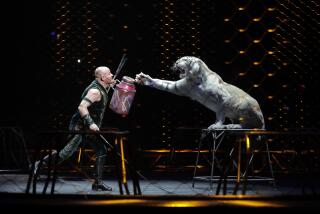SeaWorld parks to resume killer whale shows after trainer’s death
- Share via
Reporting from Orlando, Fla. — SeaWorld Orlando and its sister parks in San Diego and San Antonio will resume performances of their killer whale shows Saturday, although trainers will be forbidden from swimming with the animals while the company investigates what led to this week’s fatal attack by one of its orcas.
Tilikum, the 6-ton killer whale that pulled a veteran trainer underwater to her death Wednesday, will not perform Saturday. The company had suspended its popular show in Shamu Stadium after the death of trainer Dawn Brancheau.
But SeaWorld officials said they intended to continue using Tilikum -- who delights audiences with outsized splashes -- in its performances.
“He’s been a part of our team and he will remain a part of our team,” SeaWorld Parks & Entertainment President Jim Atchison told reporters during an afternoon news conference Friday. Removing Tilikum from shows “would be a shame,” he said.
“This is really a wonderful animal and his participation in our shows, his engagement in our interactions and so forth is very important to his overall health and husbandry,” he said.
The announcement came three days after the orca pulled Brancheau into the water by her ponytail in front of park visitors. Brancheau, 40, died of “multiple traumatic injuries” and drowning, the Orange County Sheriff’s Office said.
Park officials said that they would establish the Dawn Brancheau Memorial Charitable Foundation, and that a video tribute to the trainer would be featured in Saturday’s Shamu show.
Tilikum has been valuable property for the resort, both as a stud who has fathered 13 calves and as a performer. But the characteristics that make the killer whale so prized -- testosterone and size -- also make him especially dangerous for the trainers who work with him, some orca experts said.
Chuck Tompkins, corporate curator of animal behavior for SeaWorld Parks & Entertainment, said the park’s female killer whales typically want Tilikum around them only when they are sexually active.
Tilikum spends as many as three days alone, though never longer. But some experts said extended periods of isolation can be stressful for a killer whale, an inherently social animal. That, they say, can in turn make them prone to unpredictable behavior such as that exhibited Wednesday.
The tragedy has stirred renewed criticism from some animal-rights activists and orca experts who contend that orcas should not be held in captivity.
One expert suggested that building a tank as big as Rhode Island wouldn’t be large enough for a male the size of Tilikum, capable of traveling 100 miles in a day.
However, reintroducing Tilikum to the wild would be costly, include serious risks for the animal and probably not guarantee his survival, experts said.
Brancheau’s death has prompted questions about whether it is safe for trainers to work with Tilikum, who has been linked to three deaths in 19 years.
In 1991, while at the now-defunct Sealand of the Pacific aquarium in British Columbia, Canada, Tilikum and two other killer whales drowned a trainer who had fallen into the tank. And in 1999, Tilikum was found with a man’s dead body draped across his back; authorities said the man had sneaked into SeaWorld after hours.
SeaWorld long has acknowledged that the killer whale was particularly dangerous. Tilikum was the only orca of the 25 held in all three SeaWorld parks that trainers were not allowed to swim with. Only the most experienced trainers -- including Brancheau -- were permitted to work with Tilikum from the water’s edge.
Atchison said that colleagues from other sea mammal facilities in Georgia, Miami and Niagara Falls, and members of the Navy, would help in the review of Brancheau’s death.
“We’re hoping if we get new eyes on this, we’ll find something we missed,” he said.
jgarcia@ orlandosentinal.com
wpacheco@ orlandosentinal.com
Sentinel staff writer Dewayne Beville contributed to this report.
More to Read
Sign up for The Wild
We’ll help you find the best places to hike, bike and run, as well as the perfect silent spots for meditation and yoga.
You may occasionally receive promotional content from the Los Angeles Times.






